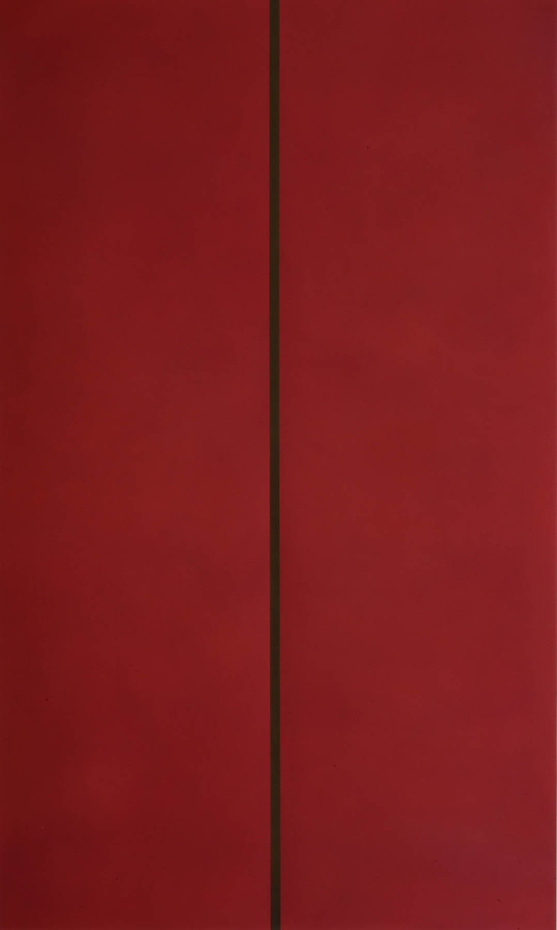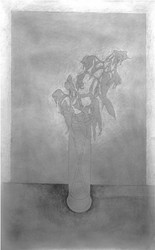Three flat rectangular things with a stripe of colour running centrally from top to bottom, produce the effect of simultaneous contrast. Each of the central stripes is modified by the context in which ‘it finds itself’. Such stuff is commonplace. They stand, paper on aluminium, off the wall, crisp edged in the eye. What are they? They are displayed in the manner of ‘pictures’, have some pictorial attributes.
They could BE pictures ‘of’ something in the manner of a detail of a detail…. There is no way to ascertain that there is a place, event, encounter of which they are a description. But there are evocative qualities, shape, line space at play. Still though they might not point to anything , or any ‘thing’ in particular, or maybe point to memories, things half forgotten, to feelings and needs. They come from……, they are present. They ‘Present’ themselves. I came across a stone, in Sartre’s ‘Nausea’. The stone stayed with me as the rest of the novel drifted away. There is something of the insistent quality of a stone in the hand, that connects to colour in the eye. Do these things with a line insist in a similar way? Just as a stone is simply a stone, stone-like, hard, so colour is only colour, in your face, divided colour that separates and binds, like the stone in the hand, inexplicable.
At the heart of all this is a matter of haptic belief, faith, softness firmly gripped.
I am reminded of a time when I sat in my dining room writing a piece for my a-n blog. I looked out onto the lawn just as a mouse ran across it carrying a large lump of bread doing his mousy thing with what seemed a determined sense of purpose. Intentional in its actions, determined in its effort, the mouse was in a hurry. And being in the open is not safe for a mouse. I imagined it scurrying with whatever anxiety a mouse might feel. On the other hand there might simply have been an almighty sense of mousy joy
Anyway the mouse was just getting on with being mousy, just getting on with it. I rather envied it. Is it more difficult to be an artist just getting on with it? Perhaps at one level it ought not to be. A common misconception about some art and its makers is that it is a pleasurable activity, a pleasure to do art and a pleasure to be an artist.
I came across the work of Richard Forster at the De La Warr Pavilion(1) some time ago. Forster works from reproductions printed from digital images and photocopies of digital images. Images in a sense pushed against their grain through reproductive processes. What I see in Forster’s work and glean from his thoughts, is a notion of intense labour. The work itself at first sight has something of the photographic image about it. There is a temptation to admire extremes of technique as ends in themselves. There seems to be in this obsessive and insistent making, something that tests the artist and a need to be tested - again and again. It is as though through ‘being’ an artist, behaving as an artist, the business of making, the physical experiences of touch and sight, surprise and delight, as well as their opposites, serves to validate, to somehow make real, confirm within place and time, space and duration, the solid material being of something that turns out to be a person with a name and continuity and which is at once powerful and fragile.
1. Richard Forster ‘LEVITTOWN’
De La Warr Pavilion Bexhill-on-Sea TN40 1DP
https://www.a-n.co.uk/reviews/richard-forster-levittown-26-march-5-june/
David Minton October 2020
They could BE pictures ‘of’ something in the manner of a detail of a detail…. There is no way to ascertain that there is a place, event, encounter of which they are a description. But there are evocative qualities, shape, line space at play. Still though they might not point to anything , or any ‘thing’ in particular, or maybe point to memories, things half forgotten, to feelings and needs. They come from……, they are present. They ‘Present’ themselves. I came across a stone, in Sartre’s ‘Nausea’. The stone stayed with me as the rest of the novel drifted away. There is something of the insistent quality of a stone in the hand, that connects to colour in the eye. Do these things with a line insist in a similar way? Just as a stone is simply a stone, stone-like, hard, so colour is only colour, in your face, divided colour that separates and binds, like the stone in the hand, inexplicable.
At the heart of all this is a matter of haptic belief, faith, softness firmly gripped.
I am reminded of a time when I sat in my dining room writing a piece for my a-n blog. I looked out onto the lawn just as a mouse ran across it carrying a large lump of bread doing his mousy thing with what seemed a determined sense of purpose. Intentional in its actions, determined in its effort, the mouse was in a hurry. And being in the open is not safe for a mouse. I imagined it scurrying with whatever anxiety a mouse might feel. On the other hand there might simply have been an almighty sense of mousy joy
Anyway the mouse was just getting on with being mousy, just getting on with it. I rather envied it. Is it more difficult to be an artist just getting on with it? Perhaps at one level it ought not to be. A common misconception about some art and its makers is that it is a pleasurable activity, a pleasure to do art and a pleasure to be an artist.
I came across the work of Richard Forster at the De La Warr Pavilion(1) some time ago. Forster works from reproductions printed from digital images and photocopies of digital images. Images in a sense pushed against their grain through reproductive processes. What I see in Forster’s work and glean from his thoughts, is a notion of intense labour. The work itself at first sight has something of the photographic image about it. There is a temptation to admire extremes of technique as ends in themselves. There seems to be in this obsessive and insistent making, something that tests the artist and a need to be tested - again and again. It is as though through ‘being’ an artist, behaving as an artist, the business of making, the physical experiences of touch and sight, surprise and delight, as well as their opposites, serves to validate, to somehow make real, confirm within place and time, space and duration, the solid material being of something that turns out to be a person with a name and continuity and which is at once powerful and fragile.
1. Richard Forster ‘LEVITTOWN’
De La Warr Pavilion Bexhill-on-Sea TN40 1DP
https://www.a-n.co.uk/reviews/richard-forster-levittown-26-march-5-june/
David Minton October 2020

